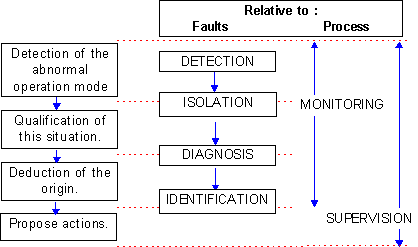
Fig. .1 Supervision tasks.
1.6 IFAC definitionsThe terminology used in the literature in the field of supervision fault detection and diagnosis is not unique. Consequently, the Technical Committee SAFEPROCESS tried to find commonly accepted definitions. Some of these preliminary proposals are collected in [Isermann and Ballé, 1996]. The terminology used in this text has been transcribed when used with a similar meaning, and redefined when used with a different significance (such topics are marked with an asterisk, *) :
About states and signals :
About functions:Fault : Unpermitted deviation of at least one characteristic property or variable of the system. Malfunction : Irregularity in fulfilment of a systems desired function. Error : Deviation between a measured or computed value of an output variable and the specified or theoretically correct value. Disturbance : An unknown (unmeasurable and uncontrolled) input acting on a system. Perturbation : An input acting on a system which results in a temporary departure from steady state. Residual : Fault indicator, based on model equations. Symptom* : Change of the observed behaviour with respect to the normal one. Although all of these topics exist in the bibliography and correspond to different stages in the study of faults of plants, the majority of works in the domain are centred on: fault detection, fault diagnosis, monitoring and supervision.Fault detection : Determination of faults present in a system. Fault isolation : Determination of kind, location and time of detection of a fault. Follows fault detection. Fault diagnosis* : Determination of the origin of a fault. Therefore, it follows fault detection. Monitoring : A continuous real-time task of determining the condition of a physical system. Supervision : Monitoring a physical system and taking appropriate action to maintain the operation in the case of faults. Protection : Means by which a potentially dangerous behaviour of the system is suppressed if possible or, means by which the consequences of a dangerous behaviour are avoided. About models :
About system properties and its measures:Quantitative model : Use of static and dynamic relations among system variables and parameters in order to describe systems behaviour in quantitative mathematical terms (also called analytical or numerical model). Qualitative model : use of static and dynamic relations among system variables and parameters expressed in symbolic terms in order to describe systems behaviour in qualitative terms. Diagnostic model : A set of static and dynamic relations which link specific input variables -the symptoms- to specific output variables- the faults. Analytical redundancy : Use of two or more, but not necessarily identical ways, to determine a variable where one way uses a mathematical process model in analytical form. The scope of supervision is not only to detect malfunctions and faults, but also to propose actions against these situations. Therefore, basic tasks associated to a supervisory system have a correspondence with fault diagnosis, [Gentil, 1996], and other fault related tasks. Once faults are detected and localised, actions can be proposed or ordered to assure global performances. See Fig. 2.1 for the relationship between tasks and terminology.Reliability : Ability of a system to perform a required function under stated conditions, within a given scope, during a given period of time. It can be expressed by the Mean Time Between Failure (MTBF). It is the mean value of time passed between two consecutive failures Safety: Ability of a system not to cause a danger for persons or equipment or environment. Other terms such as, availability or dependability, are less frequent terminology, referring to probability of satisfactory operation of systems through time. They are not used in this text.

Fig. .1 Supervision tasks.